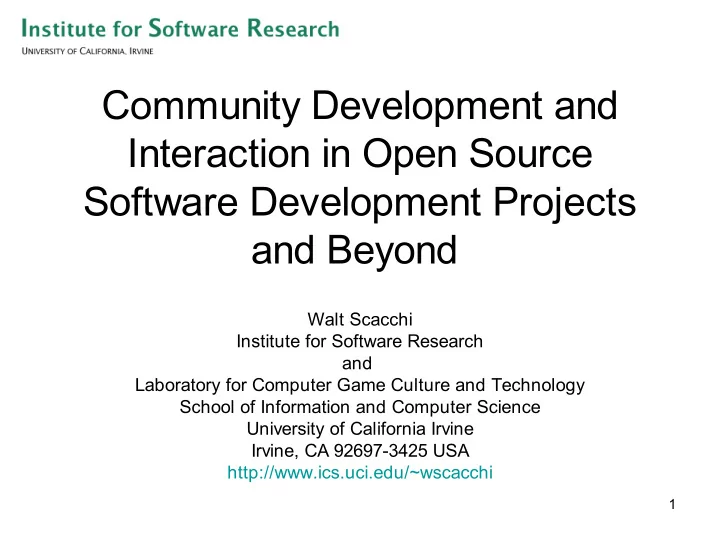

Community Development and Interaction in Open Source Software Development Projects and Beyond Walt Scacchi Institute for Software Research and Laboratory for Computer Game Culture and Technology School of Information and Computer Science University of California Irvine Irvine, CA 92697-3425 USA http://www.ics.uci.edu/~wscacchi 1
Overview • Focused on free/open source software development practices and communities – Free (GPL) is always open, but open is not always free. – Empirical studies (qualitative, ethnographic, process-centered) • Practices for requirements, configuration, evolution, project management, technology transfer and licensing. • Examples drawn from the F/OSS Computer Game community – Fourth largest community of F/OSS projects on SourceForge.net (>8K projects). 2
F/OSS Processes for Software Requirements or Design • F/OSS Requirements/Designs – not explicit (no declared reqs/design artifacts) – not formal (no notation-based artifacts) • F/OSS Requirements/Designs are embedded within “informalisms” – Example OSS informalisms to follow (as screenshot displays of online artifacts) • F/OSS Requirements/Design processes are different from their SE counterparts . 3
SE vs. F/OSS processes for Requirements • Elicitation • Post-hoc assertion • Analysis • Reading, sense-making, accountability • Specification and • Continually emerging modeling webs of discourse • Validation • Condensing and hardening discourse • Global access to online • Communicating and discourse managing 4
Retrospective requirements specification example 5
Configuration management and work coordination • Use CM to coordinate and control who gets to update what part of the system – Many F/OSSD projects use CVS (single centralized code repository with update locks) and frequent releases ( daily releases on active projects) – Linux Kernel: BitKeeper (multiple parallel builds and release repositories) – Collab.Net and Tigris.org: Subversion (CVS++) – Apache: Single major release, with frequent “ patch ” releases (e.g., “A patchy server”) 6
Concurrent version system (CVS) for coordinating source code updates 7
Evolutionary redevelopment, reinvention, and revitalization • Overall evolutionary dynamic of F/OSSD is reinvention – Reinvention enables continuous improvement • F/OSS evolve through minor mutations – Expressed, recombined, redistributed via incremental releases • F/OSS systems co-evolve with their development community – Success of one depends on the success of the other • Closed legacy systems may be revitalized via opening and redistribution of their source – When enthusiastic user-developers want their cultural experience with such systems to be maintained. 8
Revitalizing legacy applications via open source example 9
Project management and career development • F/OSSD projects self-organize as a layered meritocracy via virtual project management – Meritocracies embrace incremental mutations over radical innovations – VPM requires people to act in leadership roles based on skill, availability, and belief in project community • F/OSS developers want to have fun, exercise their technical skill, try out new kinds of systems to develop, and/or interconnect multiple F/OSSD projects ( freedom of choice and expression ). 10
A layered meritocracy and role hierarchy for F/OSSD (images from A.J. Kim, Community Building on the Web , 2000) 11
Virtual project management example 12
Example of F/OSS development patterns that encourage having fun and getting a new job 13
Software technology transfer and licensing • F/OSS technology transfer from existing Web sites is a community and team building process – Not (yet) an engineering process – Enables unanticipated applications and uses – Enables F/OSSD to persist without centrally planned and managed corporate software development centers 14
Example of F/OSS technology transfer that enabled creation of new kind of application (e.g., online virtual dancing) 15
Free/OSS licenses Reiterate and institutionalize F/OSS culture (values, norms, and beliefs), and thus act to sustain F/OSS communities – GNU Public License (GPL) for free software – More than 35 other open source licenses ( http://www.opensource.org) – “Creative Commons” Project at Stanford Law School developing public license framework (see http://www.creativecommons.org) 16
17
Implications • F/OSSD is a community building process – not just a technical development process – F/OSS peer review creates a community of peers • F/OSSD processes often iterate daily versus infrequent singular (milestone) Software Life Cycle Engineering events – F/OSSD: frequent, rapid cycle time (easier to improve) vs . – SLC: infrequent, slow cycle time (harder to improve) 18
Game World Stats Game World Stats 19
Conclusions • Developing F/OSS is different than software engineering – not better, not worse, but different and new – more social, more accessible, more convivial, more community oriented. • F/OSS systems don’t need and probably won’t benefit from classic software engineering. 20
Conclusions Conclusions • Jointly conducting R&D in F/OSS computer Jointly conducting R&D in F/OSS computer game culture, technology, and community game culture, technology, and community • Breaking down barriers between art, science, Breaking down barriers between art, science, technology, culture through F/OSS computer technology, culture through F/OSS computer games, game environments, and experiences games, game environments, and experiences • Creating a new generation of informal Creating a new generation of informal learning tools and techniques, together with a learning tools and techniques, together with a global community of developers and users. global community of developers and users. 21
Open source software research Web site at UCI 22
Acknowledgements • Project collaborators : – Mark Ackerman, University of Michigan, Ann Arbor – Les Gasser, University of Illinois, Urbana-Champaign – John Noll, Santa Clara University – Margaret Ellliot, Chris Jensen, UCI-ISR – Julia Watson, The Ohio State University • Funding support : – National Science Foundation, ITR#-0083075, ITR#- #0205679, ITR#-0205724, and ITR#-#0350754. – No endorsement implied. 23
References see http://www.ics.uci.edu/~wscacchi • W. Scacchi, Understanding the Requirements for Developing Open Source Software, IEE Proceedings--Software , 149(1), 24-39, 2002. • W. Scacchi, Open EC/B : A Case Study in Electronic Commerce and Open Source Software Develo , Final Report, July 2002. • W. Scacchi, Free/Open Source Software Development Practices in the Computer Game , IEEE Software , Special Issue on Open Source Software, (to appear, Jan-Feb. 2004). W. Scacchi, • Understanding Free/Open Source Software Evolution: Applying, Breaking , revised version to appear in N.H. Madhavji, M.M. Lehman, J.F. Ramil and D. Perry (eds.), Software Evolution , John Wiley and Sons Inc, New York, 2004. 24
Recommend
More recommend